Peter Dornauf – 8 April, 2025
Sculptural creations tend to be treated like the second bridesmaid, unless they are large outdoor public structures, or huge indoor house size installation jobs. So it is gratifying to see a sculptural award—that is, 'Small Sculptural Award' (SSA), inaugurated by the Waikato Society of Arts in Hamilton at Artspost—become a biannual event, open to practicing sculptors nationwide.
Like print works in the hierarchical stable of art, sculptural creations tend to be treated like the second bridesmaid, unless they are large outdoor public structures, or huge indoor house size installation jobs. So, it is gratifying to see a sculptural award—that is, Small Sculptural Award (SSA), inaugurated by the Waikato Society of Arts in Hamilton at Artspost—become a biannual event, open to practicing sculptors nationwide.
What is also apposite are the sponsors, Longveld, an engineering team who have been responsible for the fabrication of some substantial national and local sculptural works, two of which have Waikato connections - Eugene Kara and Fred Graham, both with pieces positioned along the Waikato Expressway.
The judge for the show, sculptor Glen Haywood, selected 30 works from 90 entries submitted, and their diversity and originality was a pleasure to behold, a wonderful array of forms employing every medium and contrivance imaginable. It was a smorgasbord of visual delightto be enjoyed while moving through the gallery space.
One of the most entertaining, even a little disturbing, was Jonathan Campbell’s Night Shift, a metallic concoction of things - industrial power switch complete with stubbed out cigarette, vine like tendril growing out of the mechanism, at the end of which dangled the skeletal head of a long beaked bird. Part surreal, part industrial symbol, it conjured dark images of long protracted nights inside some dim lit complex where nightmarish things might have gone on. Perfectly executed.
A more joyful construction that evoked a nostalgic feel from the 1950’s was Annie Smits Sandano Play Thing 3. Both colour, form and composition helped to present simple geometric shapes that called to mind children’s building blocks, while at the same time alluding to design forms belonging to a mid-twentieth century aesthetic. Both clever and elementary at the same time.
Emma Page’s piece Echo (blue) was simplicity itself. A readymade with added blue paint, the artist was obviously channelling the Dadaists here. It was merely a brown paper bag, the interior done out in a glowing ice blue hue. There was no arch criticism involved here or grand pronouncement about consumerism, or finger wagging polemic - just a sense of playfulness while drawing attention to the sculptural potential in ordinary objects.
Minimal means but maximum delight.
One work that did deal with the troublesome topic of materialism was that of Llyr Williams. Called Crude, it consisted of a rather expensive looking leather handbag with long shiny fake gold chain hung up on the gallery wall, the leather dripping with black Antimar paint. Another altered readymade, it made its point with modest means, one the artist revealed to be personal, confessing to getting “caught up in the allure of shiny new things”, only to feel pangs of regret later. Ouch!
Lucy Clement was also a little discombobulated. Her This Way, That Way textile sculpture consisted of a series of plump stuffed arrows curled around like a contortion of snakes and pointing in a dozen different directions at once, encapsulating the conundrum of decision making. Both tactile and visually engrossing.
If you crave something a little spooky, you’d be advised to take in Stuart Bridson’s piece, Harmony in the Emancipation of Dissonance. The title itself is enough to unsettle, but then the sculptor talks about “panpsychism”. It’s all about consciousness and who’s got it. Are we looking at these objects, or are they looking at us?
I greatly enjoyed the interesting conjunction of different forms in this show that projected a sense of urban environment via symbolic notation, emphasizing at the same time a certain artificiality in its contrived brutalist configurations.
The smallest work was Peter F Muller’s jewellry-sized piece, Corrugated Wave, 2 fingering. Made of sterling silver and pounamu, its delicacy and diminutive size combined forms that were arrestingly mismatched and yet were made to look strangely compatible.
The winner on the night, Marion Manson’s Recharted Realms, repurposed pages from the Reader’s Digest World Atlas and turned them into a form and statement that had to do with things society had discarded. “Fragility of memory” was the artist’s focus.
There was a good deal of repurposing as means and method in the show and the runner-up, Nicholas Males with his Dial-up Fortune was of this stripe, simply employing an old 1989 corded telephone, but using new technology to install an LCD unit that flashed texts involving corporate jargon in order to “critique the emptiness of modern communication.”
A similar work, A horse of a different colour, by Monique Lacey, employed a very ordinary cardboard box, but then by crunching it up and cleverly painting it silver, made it look like a solid metallic object. I was completely fooled. Which is what the artist wanted, highlighting the problematic situation we face in a world of AI and fake news.
This was a unequivocally engaging show, full of energetic and innovative constructions that drew one in and left one feeling happily satisfied after contemplation was complete.
Peter Dornauf
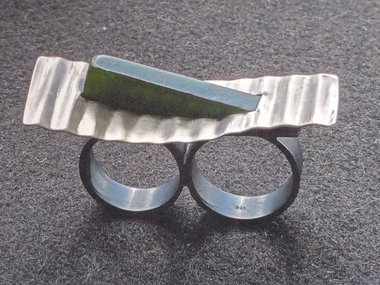
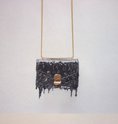

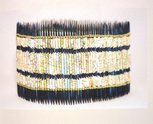



 Two Rooms presents a program of residencies and projects
Two Rooms presents a program of residencies and projects Advertising in this column
Advertising in this column
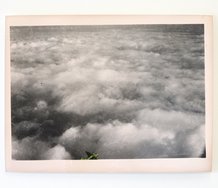
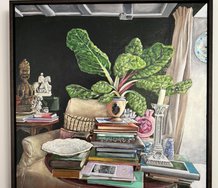

This Discussion has 0 comments.
Comment
Participate
Register to Participate.
Sign in
Sign in to an existing account.